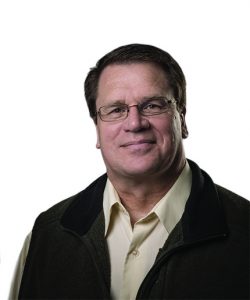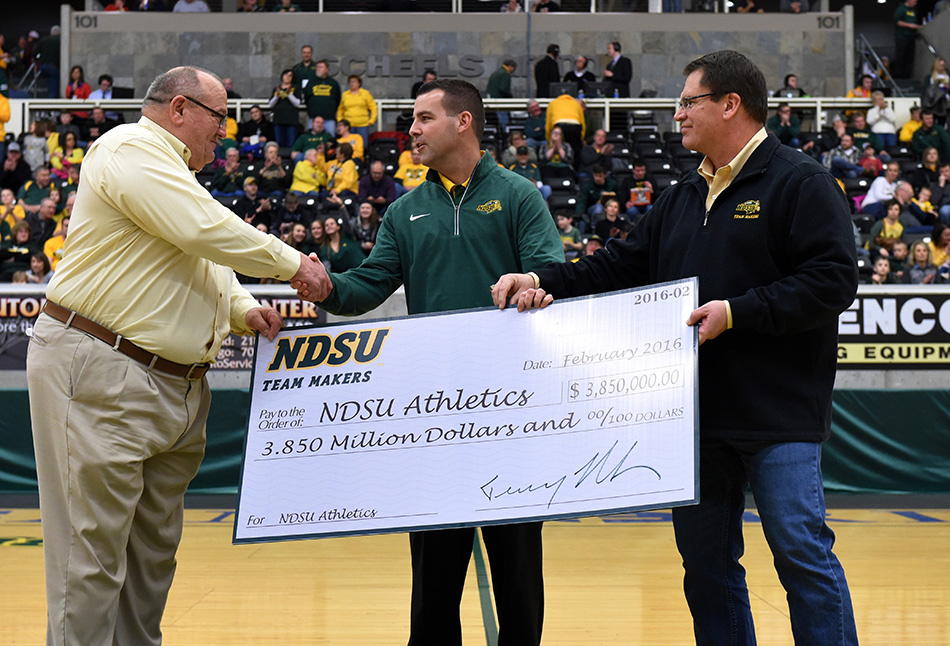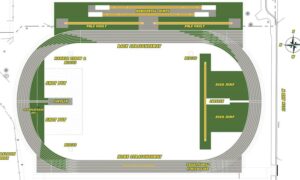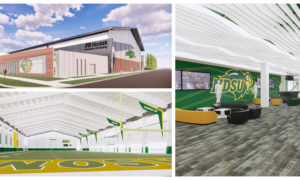There will be a changing of the guard at the Presidential-level of Team Makers this January.
Terry Ludlum became Team Maker’s president in January 2015. The road to the presidential role was a long time coming for this avid philanthropic Bison fan. What started as a way to meet with friends and talk about their favorite Bison-related subjects, being a Team Maker quickly turned into a way of life for Ludlum. He wasn’t satisfied with just going to games and cheering from the stands. This NDSU alum wanted to find an avenue for him to help a program he held close to his heart. A “Bison Insider” opportunity was possible with his commitment to NDSU Athletics through Team Makers.
Ludlum served as the first two-year Team Maker president. The change in the Team Maker executive committee structure allowed Ludlum to chase more ambitious goals for the NDSU Athletics fundraising group. He received the opportunity to work more diligently with Director of Athletics Matt Larsen on projects like extending the budget over three-year, five-year and 10-year periods. They explored potential revenue sources and continually growing Team Maker membership.
In 2016, Team Maker’s expanded their budget by 33 percent to $5.2 million. Membership has also jumped to over 4,000 members. It was a successful two years as president for Ludlum. Now, his focus will shift to the two years he will spend on the executive committee as the past president.
Here’s what he had to say about his time as President and his goals for the future of Team Makers.
Bison Illustrated: When you decided to jump into more of a leadership role with Team Makers, how did your mindset change into more volunteerism?
 Terry Ludlum: “I think the one thing that’s changed most in the years that I’ve been involved. It’s gone from being able to join Team Makers to get a seat (in the Fargodome) to now, there haven’t been seats available for a number of years. So it’s truly a philanthropic adventure to go out and raise funds, and so people need to give for the right reasons, as opposed to getting a better seat. Now, those that want to pay more, you’re really not only getting involved in Team Makers to support football, you’re getting involved in supporting every athlete in every program.”
Terry Ludlum: “I think the one thing that’s changed most in the years that I’ve been involved. It’s gone from being able to join Team Makers to get a seat (in the Fargodome) to now, there haven’t been seats available for a number of years. So it’s truly a philanthropic adventure to go out and raise funds, and so people need to give for the right reasons, as opposed to getting a better seat. Now, those that want to pay more, you’re really not only getting involved in Team Makers to support football, you’re getting involved in supporting every athlete in every program.”
BI: Team Maker dues for season tickets have been a hot topic around Bison Nation. What’s the strategy behind that?
TL: “So Bruce (Grubb, the past president who spearheaded the ticket redistribution) and (Pat) Simmers and I met at Labby’s every Friday afternoon for a month, and we went through the print out of what everybody was paying for every seat in the dome. We started to go through and check off who we thought was at somewhat of the market value, who was below, was there anybody above, and if they were above, should that dictate the market value. That was the start of what to do and what we think this section is worth. What are folks paying for now, and what do we think they would pay.”
BI: Do you ever see those season tickets ever reaching their market value?
TL: “There’s a program in place and they want to have that in place probably within the next six years. So, anybody who’s deemed at below the current market value, they were sent a letter last year saying that you will see these increases over these seats. And if that’s something you’re uncomfortable with, please let the athletic department know, let Josh Hemingway know that if seats might open up in different areas, we can move those around.”
BI: Did fans understand they were paying under the market value for these seats and that you’re doing this to ultimately help the athletic program and not just jacking up prices because you can?
TL: “There were some folks that responded immediately who said, ‘We think you’re being greedy that you’re gouging.’ But again, when you’ve got 600 groups waiting in line for the tickets, we’re trying to balance that to the loyalty component of it. We felt that this was addressing the loyalty component along with, if you’re uncomfortable, we can seat you somewhere else when they become available. Once we realize where we’re going, what kind of numbers do we truly need to satisfy the scholarships, then we knew we needed those revenue sources also.”
BI: What was it like being the president of this fundraising organization when NDSU went forward with cost-of-attendance?
TL: “We had a budget established, then Matt (Larsen) came forward and said, ‘Okay, gentlemen, what are your thoughts here? Do we want to look at cost-of-attendance and if we do, how do we want to implement that? Do we want to select certain athletes? Do we want select certain teams, certain programs?’ And I think, it quickly came out from a consensus standpoint, that if we’re going to fund cost-of-attendance, we’re doing it across the board, every sport and every athlete.”
 BI: How has the Sanford Health Athletic Complex reinvigorated NDSU and the fan base?
BI: How has the Sanford Health Athletic Complex reinvigorated NDSU and the fan base?
TL: “I think the thing the NDSU Athletic program did, even though they were under a lot of pressure to finish that project, they really handled that well. And I say that because they made it available for everybody to go in there, based on their priority points. They were scheduled times to go in, look at the seats, select their seats, sit in them and decide if this is going to be a good fit for me. They advertised the dollar values extra for seats, to go to Team Makers, based off that, folks can pick their seats and I think we’re really excited about the numbers that generated were about 4,500 folks now that have their season tickets, and so that’s up. I think that’s up probably six or seven hundred over the last year. I think within a couple years, we’re going to see the SHAC seating scenario exactly how the Fargodome seating scenario is. I think there’s going to be single-game tickets you’ll be able to buy and after that, you might be getting into the waiting list.”
BI: What can you tell us about the incoming president, Kris Bakkegard?
TL: “He’s been very involved in Bison Athletics, a great supporter. I think he’s going to bring a young businessmen’s approach to it. What that means is that I think with him, exposure and contact are going to be really important to him. That’s one thing that we tried to do, and that Kris is really good at is a couple of things: Let’s get out and visit with our fundraising teams that we have and let’s get out and visit with the student-athletes. We thought it was really rewarding to get up and out to touch base with the student-athletes, not on a one-on-one setting, but when they have their annual banquets when they have their annual kickoffs. Get in there and visit with the coaches and these folks, and get a little bit of exposure to these folks and tell them what Team Makers is all about. Some of them were truly shocked when I started introducing them. I’d ask, ‘Does anybody in here know what Team Makers is?’ They said, ‘We’ve heard of you.’ We said, ‘Well, we raise money for your scholarships.’ They said, ‘Oh, really?’”

BI: What would you say about pushing for more contact with the individuals in the program?
TL: “I would always say, within the last few years, we’ve had an understanding between, an unwritten understanding between the Team Makers executive committee and NDSU athletic administration, that we’re going to step up and we’re going to work hard to raise the funds, for all student-athletes that is allowed by NCAA rules. So tuition, room and board, all the scholarships and now cost-of-attendance, we’ll fund that. But then there’s something that we need you folks to make a commitment toward. When the coaches go out (recruiting), number one, find good people. These people then are the future of the community the future of these programs. So let’s find people that you think should be representing (NDSU). From an academic standpoint, are they good students? Because again, we want to bring these folks into our communities, into our businesses. We want to be able to recommend these people for jobs. From an academic side, it’s incredibly important. Then, obviously, let’s bring in the good athletes, too, to make sure our programs are successful. We think that little-unwritten agreement with the administration is working out fantastically. We’re stepping up, we’ll gather as much money as you need.”
BI: What’s going to be your role now as the past president?
TL: “I see the past president’s role on the committee as to get the new members acclimated to the system. If you’re going to give a $100 to Team Makers, it’s important that everybody on the executive committee and the fund drive committee understands where that $100 is used. And that’s been a difficult thing because they’re used to be so many different funding components—through Team Makers and the Alumni Association—you have a clouded message as to where it was going. I think now and over the last few years, we’ve done a better job of defining and saying, ‘Yours goes toward the scholarships. Wonderful. In this fund, it goes toward brick and mortar.’ We’ve clearly defined those, so now I think that’s the role of the past president, is to be able to pass that message along to the executive committee. And then, the other part of it is to look for new folks that want to come on the executive committee that are interested in it because now, with the two-year term of offices, you’re looking at about a nine, 10, 11-year commitment.”
BI: We’ve seen a push to get more young professionals involved. Will that continue?
TL: “That’s really been an important side of what we’re trying to do recently is making sure that we have different philosophies on the committee. Those that understand the athletic system and those that have been a part of it, like former athletes, and then that young business model that comes in with different ideas. I think it’s important we continue to nurture that a little bit and then go out and find these folks to continue making this stronger. We’re dealing with a completely different critter. Back, not very long ago, about 12 years ago, we were dealing with $600,000 and about 700 members. Now we’re in the $5.2 million range and 4,000 members so it can’t be that same executive committee philosophy. That ‘I’ll just shake hands with everybody’ way of thinking, that’s getting a little more difficult.”
BI: Anything else you’d like to add about your time as president?
TL: “I think the one thing that I take the most pride in is that we’ve really been able to reach some kind of consensus with the NDSU athletic administration as to what type of people we want coming. We want good people coming in here and again, good students and good athletes. In that order. And they’ve been really been able to go out there and satisfy all of those wants and need that we have because again, we’re more than willing to raise the funds that are needed and to stand behind that commitment. But we need that commitment from the administration, coaching staff and the athletes, and I think we’ve been able to transition into that over the last few years.”
“We’re dealing with a completely different critter. Back, not very long ago, about 12 years ago, we were dealing with $600,000 and about 700 members. Now we’re in the $5.2 million range and 4,000 members…” – Terry Ludlum









